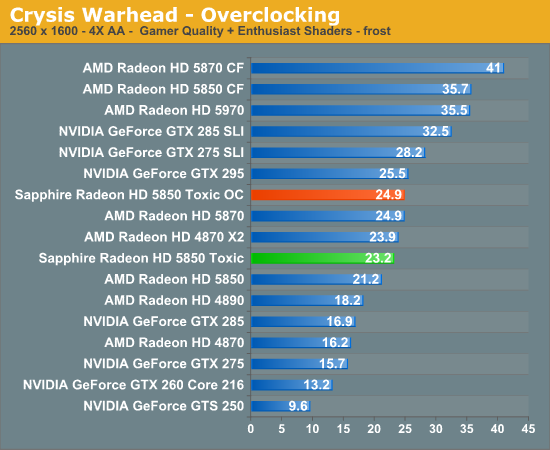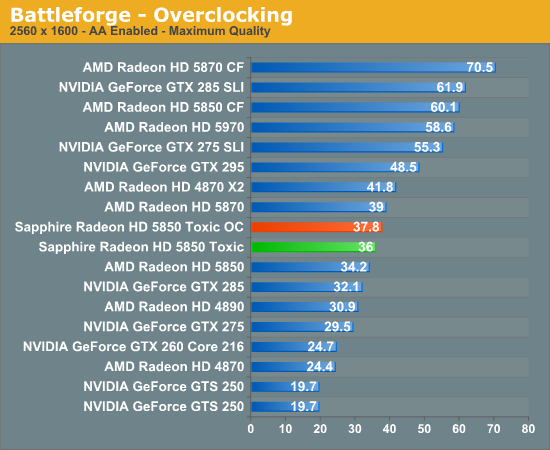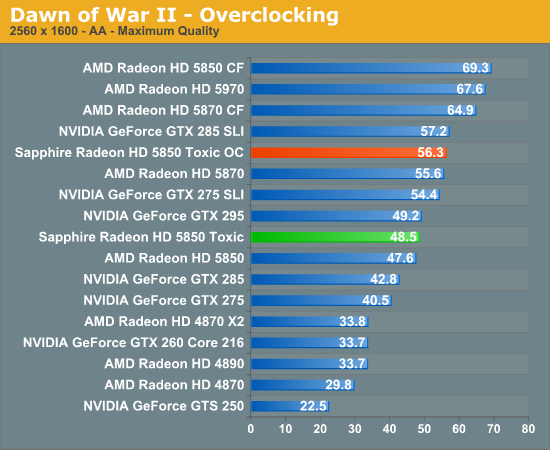Sapphire’s Radeon HD 5850 Toxic Edition: Our First Fully-Custom 5850
by Ryan Smith on February 18, 2010 10:00 PM EST- Posted in
- GPUs
Overclocking
With Sapphire’s superior Vapor-X cooler, the 5850 Toxic is a strong candidate for overclocking. However currently none of our overclocking tools know how to overvolt the card, so any overclocking is limited to what you can get at the 5850’s stock voltage: 1.088v.
With that in mind, we were able to use the AMD GPU Clock Tool to push our card by a further 130MHz on the core to 895MHz, and an additional 50MHz on the memory to 1175MHz. This is 17% core overclock and 4% memory overclock respectively. Thus unlike the already overclocked Toxic card, the games that will respond the best here are those that are GPU limited instead of memory bandwidth limited.



Out of the 3 games we’re taking a look at for overclocking results, the benefit varies wildly. Battleforge is rather insensitive at only a 5% performance increase, while Dawn of War II is nearly linear with the GPU clockspeed increase, for 16%. Thus our results are much like the benefit of Sapphire’s factory overclock in the first place: there’s no rule of thumb, the benefit of overclocking is going to vary wildly depending on the game.
We should note that at these clockspeeds we’re some 23% faster than the 5850’s GPU clock speed, and 17% faster than its memory clock speeds. Thus at these maxed out levels, our further overclocked 5850 Toxic is 17% faster at Crysis, 10% faster at Battleforge, and 18% faster at Battleforge. What’s particularly noteworthy is that the overclocked Toxic actually manages to best the 5870 here, even though the 5870 has another SIMD to work with. This indicates that Battleforge it bottlenecked by the ROPs, or at some point in the fixed-function pipeline.
Temperature, power, and noise results for our overclocked 5850 Toxic are on the next page.










71 Comments
View All Comments
just4U - Friday, February 19, 2010 - link
Yeah turned out to be Java:selace ... Don't know where the hell I could have picked it up from. Ah well cleaned after a full check.7Enigma - Friday, February 19, 2010 - link
It's not from Anand's site, though I've gotten that at work from another site which resulted in a hosed system (they use an old version of IE without popup blocker and won't let 3rd party browsers be used...).just4U - Friday, February 19, 2010 - link
I am using IE8 here with all security patches in play. Going to do a full scan with Malwarebytes and MS SecurityE and see if they pick anything up.. just did quick scans afterall.It bypassed the popup blocker initially and showed a small prompt on screen saying I may be infected. Closing and canceling had no effect as it still re-routed my browser to a look-alike Vista control panel type page.
7Enigma - Friday, February 19, 2010 - link
Please in the future when testing a factory overclocked card highlight the STOCK card in the graphs. It's frustrating to constantly hunt through the cards in each chart to see the difference between the stock 5850 and the Sapphire card.Thanks.
legoman666 - Friday, February 19, 2010 - link
You mention an overdrive clock limit of 775. My 5850 is currently running at 825 overclocked via CCC. It goes even higher; somewhere around 900. Why are you using the 9.9s when the 10.2's are available? Maybe that's why your overclock is so limited.Ryan Smith - Friday, February 19, 2010 - link
It's not a driver issue. The OD limit is hardcoded in to the BIOS. My reference 5850s have the same 775/1125 limit.What 5850 do you have? None of them should be shipping with a higher overdrive limit from what AMD tells me.
legoman666 - Sunday, February 21, 2010 - link
http://i28.photobucket.com/albums/c241/legoman666/...">http://i28.photobucket.com/albums/c241/legoman666/... @ 825legoman666 - Sunday, February 21, 2010 - link
http://i28.photobucket.com/albums/c241/legoman666/...">http://i28.photobucket.com/albums/c241/legoman666/...I have an Asus EAH5850. It's at stock clocks in the pic, but I've had it up to ~880.
Barneyk - Friday, February 19, 2010 - link
That was a bit strange to me. The card keeps most of the heat dissipated from the card in the case and it produces more heat then a standard 5850.So if you have a very well-ventilated case I guess its not an issue but what if you dont?
Would you still recommend it?
erple2 - Friday, February 19, 2010 - link
I don't think that he mentions what portion of the heat the Toxic vents into vs. out of the case. However, it would stand to reason that a well-ventilated case would be important either way.That does bring up an interesting point, however, that may be outside of the scope of this article. I'm assuming that all of the testing is done in a well-ventilated case. If the temperatures inside of the case were sufficiently high enough, it would start to impact the temperature of the card significantly. Given that the Toxic runs "cooler" than the stock card, one of two things is true:
1. The recirculating temperature problem is a non-issue
2. The case Ryan uses is well ventilated and thus the temperature problem is a non-issue.
The conclusion, then, is that it's a non-issue. However, who, buying an enthusiast card like this for 300+ dollars, doesn't have a well-ventilated case? I suppose that there are people out there that don't. Perhaps an investment in a quality case would be in order? At least, case performance takes a long time to become obsolete (unlike, for example, video cards).